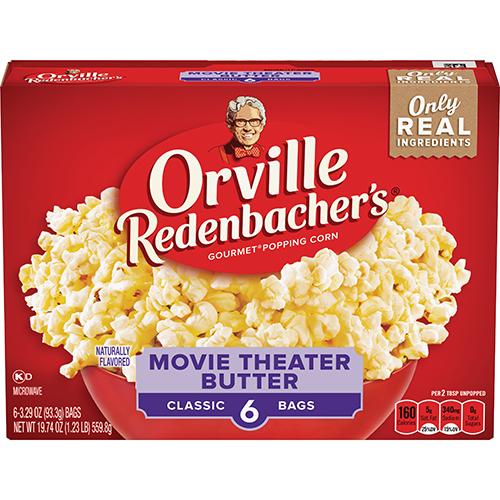It’s pretty incredible how different brands can choose to market themselves while selling the same product. Popcorn is a great example of this. Coined as one of America’s favorite snack foods, popcorn is competitive across various brands, with the majority of demands stemming from wholesale and retail supermarkets. This industry has been largely influenced by trends in recent decades, emphasizing a variety of flavors and all-natural products. In honor of National Popcorn Day, we are investigating the diverse approaches existing in the world of popcorn retail.
Orville Redenbacher
Starting with one of the most prominent competitors in the market, this brand is known for major brand loyalty among its customers. Orville Redenbacher started advertising in the 1970s on television. At the time, that was one of the most prominent ways to reach audiences. In this digital age, people are no longer gathering around the tv after dinner to watch primetime shows. People are being advertised through smartphones or tablets more than cable.
Orville Redenbacher has some social presence on Instagram and Facebook. Their Instagram has 5k followers and showcases recipes using the beloved brand’s popcorn. For a brand that has been a household name for decades, I am surprised that there is any social presence at all. It is not surprising that we are seeing a smaller presence on Instagram from Orville Redenbacher because their target audiences are more for baby boomers or gen x. Their following is much more considerable on Facebook at 397k likes and 383k followers. These generations are more active on Facebook rather than Instagram.
Act II
This next popcorn brand is one I grew up eating the most with my family for weekend movie nights. Act II, a popular popcorn brand from the 80s, bases its recipe and branding on the classic movie theater experience, particularly with its dominant buttery flavor. They have virtually no social presence; the only official social accounts are in Spanish. Their lack of social media portrays that they aren’t even attempting to keep up with other brands in the digital space.
Newer ready-to-eat popcorn brands such as BOOMCHICKAPOP and SkinnyPop have large social presences and appeal to millennials and gen z. These brands both offer healthier snacking options, and their branding follows design trends that are popular among their target demographics. Orville Redenbacher is trying to keep up with these newer brands by offering similar healthier options for their popcorn. On the other hand, Act II is not trying to compete with these brands by releasing new products; however, it still manages to remain a prominent player in the marketplace.
Angie’s BOOMCHICKAPOP
Popcorn has always been a suitable snack option, but BOOMCHICKAPOP has been a leader in contributing to this behavior by offering healthy popcorn. You know the sense of guilt you sometimes feel after snacking on something that probably wasn’t the best idea? BOOMCHICKAPOP embraces the simplicity of their ingredients, describing it as a guiltless snack. I think this is powerful because I don’t know anyone who has the self-control to only have one handful of popcorn.
The brands’ color choices of vibrant greens, yellows, pinks, and purples align perfectly with their “live out loud flavors.” The color palette is soft yet bright. Young and confident. Their slogan, “Simply. Delicious. Boom” points to the immediacy of simplicity. “Boom,” an Onomatopoeia for a loud and quick motion, speaks to the brand’s straightforward and confident personality. After all, their ingredients are as straightforward as they can be.
Boomchickapop fits right in with the healthy food trend that took off years ago. It is vegan, gluten-free, and dairy-free so that people with any food sensitivity can enjoy it.
While they have 44,700 followers on Instagram, engagement is low. Their posts consist of recipes and product photographs, and their content plan could use some improvement.
SkinnyPop Popcorn
Like Boomchickapop, SkinnyPop’s “snacking without compromise” motto embraces the value of healthy snacking. Their use of the word “skinny” as part of their brand name is not necessarily meant to be taken literally, but rather, the term suggests that the lack of artificial flavoring or additives makes it a skinny snack. To me, SkinnyPop poses the meaning of ‘skinny’ synonymously to the meaning of “healthy,” which I find problematic.
SkinnyPop’s narrow font visually echoes the meaning of skinniness. The limited color palette of their two main colors, green and white, speaks to the popcorn’s natural ingredients. Although Skinny Pop’s Instagram following is not as high as Boomchickapop’s, they’re making an apparent effort to stay relevant. SkinnyPop’s Instagram grid consists of the occasional feature of a customer’s tweet. By posting these tweets on their Instagram account, they are humanizing their brand. Posting customer tweets in the format of an Instagram post is a common and playful technique I’ve seen many other brands use on their platforms. This is also something that only younger generations can relate to, as Twitter is a much less popular platform for older generations.






